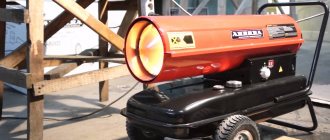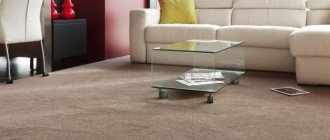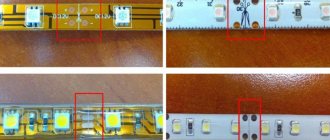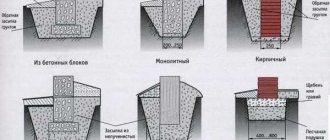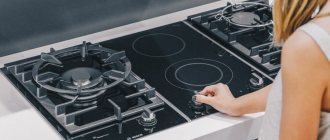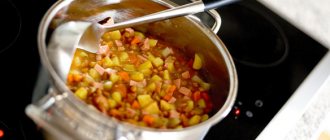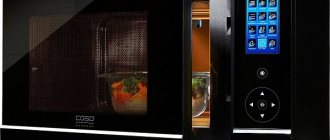What is the difference between induction and electric non-induction hobs?
Induction hobs for cooking have appeared relatively recently. In contrast, electric (ordinary) stoves have been around for decades. To increase the comfort of their use and increase sales, manufacturers have developed several separate types, each with its own characteristics. Let's take a closer look at them.
Difference in device
First of all, this type of kitchen appliance differs in design. This includes both internal parts and external execution. The functionality of the devices, their dimensions and price depend on this.
Cast iron hobs
This is one of the oldest types of kitchen equipment. They were called electric stoves and were used in the country or at work to heat water and cook food.
The equipment consists of:
- Heating element in the form of a spiral. It is made of an alloy of nickel and chromium, which makes it resistant to high temperatures and allows it to maintain its properties despite many heating and cooling cycles. The spiral is wound in a snake or in a circle and separated from the outer surface by a layer of heat-resistant insulation.
- It is closed on top with a massive cast iron disk on which the utensils are placed.
- A mandatory element of such a device is a thermostat for setting the temperature.
- To control the unit there is a switch located outside.
- Typically, the housing is equipped with a light diode to indicate connection to the network.
Cast iron hob.
The number of cast iron burners can vary from 1 to 4 and differ in diameter and power. The rest of the body is enameled, less often it is made of stainless steel. Thanks to simple components, the price of such a hob is low.
High Light hobs
The device of such a hob includes a heating element in the form of a tape. Most often it is laid in a circle. Such tapes are made from semiconductors. The technology allows for the placement of a heating element under cast iron “pancakes”, but to improve the aesthetic appearance, manufacturers began to use a glass-ceramic surface. Through the transparent plate, the light from the heated element is better visible, therefore reducing the risk of accidental contact and burns.
According to the configuration, the panel can contain from 2 to 4 heating zones, differing in diameter. Most often they are equipped with touch controls. The cost of Higt Light kitchen appliances is much higher than “classic” ones with a spiral, but remains quite affordable.
High Light Hob.
Halogen hobs
The hob with halogen technology consists of burners with two heating elements built inside: thermal and infrared. To do this, manufacturers endowed it with a spiral of semiconductor laid in the shape of a snail. A lamp is laid across it, which is a glass tube with a halogen and its own filament.
The device is complemented by a thermostat and controls. The number of burners is from 1 to 4. They are covered with glass ceramics. The price is in the same segment as the Higt Light, where the cost is influenced more by equipment with additional functions.
Halogen hob.
Induction panels
Induction panels are fundamentally different in design from all others. The outer part is made in the form of a glass-ceramic coating, and a transformer is located inside. The latter is a flat-wound induction coil. It is separated from glass ceramics by a layer of insulation. The electronic control unit regulates the voltage level.
A temperature sensor and ferrite inserts are built inside the coil. Some models use a fan for additional cooling of the element. One device body can accommodate from 1 to 4 burners of different diameters. The cost of panels of this type is much higher than others.
Induction hob.
Difference in operating principle
A short comparison of their operating principles, reflecting the efficiency of heat transfer, will help you figure out which hob to choose, electric or induction. Here's how it happens in each species:
Cast iron
The current passes through the twisted spiral and heats it to a temperature of 400 degrees. The heat is then transferred to the cast iron disc, from it to the metal pan, then to the food inside. Thanks to the thick layer of cast iron, the heat is distributed evenly and continues to act for a long time after switching off. The burners are divided by power, which is convenient for preparing large and small volumes, and also affects the boiling time of water.
High Light
The principle of operation of the hob is similar to that described above, but the tape, unlike the spiral, allows it to be positioned more tightly, which increases the amount of heat transfer area and the speed of the process increases. The semiconductor tape glows through the glass surface, which is important for safety.
Several belts can be connected in one burner through a parallel connection, which turns the burner into an entire zone, the diameter of which can be narrowed or expanded depending on the cookware being installed and the inclusion of a certain number of belts. Heat passes through the same steps: from the tape to the glass ceramics, then to the dishes and food.
Halogen
Here the operating principle is based on rapid heating by a halogen lamp and a conductive filament. This design emits both heat and infrared rays at the same time, so food heats up noticeably faster. After reaching the desired temperature, the lamp turns off and the process is supported by a conventional electric coil. Such panels work faster due to double exposure, but the heat passes through the same obstacles (panel, bottom of the pan).
Induction
The operating principle is sometimes called cold. This is due to the lack of heat generation inside the hob and its transfer to the dishes, but immediately generating heating of the food. A flat coil of a transformer passes electric current through itself and creates an electromagnetic field. This leads to the formation of eddy currents.
A pan made of a ferromagnetic alloy serves as a counterpart to the transformer and participates in electromagnetic induction. Thanks to this, the food is heated, and the glass-ceramic panel and dishes do not serve as intermediate links in heat transfer.
The principle of heating food with an induction hob.
Heating the hob
The operating principle of an electric stove is that heat is transferred to the cookware by contact with a heated burner. In other words, an electric stove simply must be hot, heat up quickly and not cool down too quickly, which entails several not very pleasant consequences.
Firstly, such a stove poses a risk of burns, especially for children and pets, and also, albeit a moderate, but still a fire safety threat.
Secondly, as the stove cools down, it releases residual heat into the surrounding air, and if it happens in the hot summer, and you also don’t have air conditioning, you can imagine what an inferno the kitchen turns into when preparing several dishes at the same time.
Thirdly, any liquid, like sauce or soup, when dropped onto a heated burner, instantly turns into acrid smoke, leaving a hard-to-remove black stain on the surface. Of course, there is a wide selection of products on sale to combat such pollution, but the very fact of the appearance of unpleasant odors and additional headaches cannot be encouraging.
An induction hob is a different matter! As mentioned above, it does not heat itself, but generates heat directly in the cookware placed on it - and this alone creates a huge gap between electric and induction cookers. Yes, an induction hob can get hot, but this will be from the heat of the cookware placed on it, and if you remove the pan from the stove, the hob will quickly cool down. There will be no burns, there will be no overheating of the air, and stains, if any, will be wiped off with much less difficulty. In short, in terms of this parameter, an induction cooker is ahead of an electric cooker by a large margin.
Induction hob – 2 points Electric hob – 0 points
Electricity consumption
Cast iron hobs come in different capacities. One burner can consume from 0.7 to 1.5 kW per hour. If the appliance is equipped with three burners with a power of 1, 1.5 and 1.75 kW, and they are turned on at full power at the same time, then such an electric hob will consume 4.25 kW.
This is one of the most uneconomical types of household appliances in the kitchen, due to long heating times and high energy consumption. Per month, with daily cooking and heating of food, up to 60 kW can be consumed per person.
Halogen and Higt Light panels are powered by a 220 V network and the power of one burner varies from 0.8 to 2.3 kW, depending on the number of simultaneously connected strips, to create a heating zone. Some models provide a double heating field with an expanded area, which is endowed with a power of 1.5-2.4 kW.
In terms of electricity consumption, they can exceed cast iron ones, but due to the rapid transfer of heat from the heating element and higher temperatures, the cooking time is reduced, so the device works less and, therefore, is more economical. About 50 kW will be consumed per person per month.
Induction hobs have a power of each burner from 1.4 to 2.2 kW. Particularly large heating zones with the possibility of expansion are equipped with transformers consuming up to 3.1-3.7 kW per hour. But due to the direct transfer of heat to the products in the container, bypassing the glass ceramics and the bottom of the cookware, this energy is spent directly on heating the food, so the operating time is even shorter than that of non-induction cookers.
In this case, it is not necessary to turn on the device at maximum power, because the heat does not need to warm up several obstacles in its path.
According to general estimates, the use of induction panels reduces energy consumption by up to 30% compared to other types.
Suitable cookware
The first thing I did when I became the proud owner of an induction cooker was to go to the store and buy an adapter, this steel pancake, which costs much more than you might expect by looking at its shape. As mentioned above, an induction cooker is capable of heating only cookware that has ferromagnetic properties, of which there were surprisingly few of the pans and pots that served me faithfully.
The adapter is capable of turning an induction cooker into a regular electric one, heating up and transferring its heat to the cookware placed on it, but it deprives it of all the advantages that will be discussed below. If you place the wrong frying pan on the induction burner, it won’t even turn on.
To understand whether a cookware is suitable for an induction cooker, attach a magnet to it or simply turn it over; the following pictogram is usually placed on compatible cookware:
At first glance, electric stoves do not have this drawback, but in practice they are far from ideal. An electric hob can only provide even heating if the cookware has a perfectly flat bottom, but even the most reliable pot or pan will warp over the years when exposed to intense heat. For the same reason, it is inconvenient or simply impossible to cook on an electric stove, using a regular wok or cauldron with rounded walls and bottom, you will have to use utensils adapted specifically for electric hobs.
Induction hob – 0 points Electric hob – 1 point
Heating rate
An important factor when choosing a hob is the heating speed, which affects the cooking time and how long the housewife will have to stand at the stove. Compared to conventional electrical panels, induction panels operate twice as fast.
During the experiments, water was boiled in the same container and on models with the same power. Thanks to the precise “targeted” delivery of heat to water, the boiling time is halved.
When you turn on the halogen and Higt Light tiles, the burner is ready in 4-6 seconds (very hot state). For induction models this figure is 2 s. The efficiency of panels with transformers reaches 90-93%, and for cast iron “pancakes” the value drops to 53%.
What to consider when choosing a cooker
The modern market offers consumers a wide range of such equipment. And a completely understandable question arises - there is an algorithm that allows you to choose a slab that is suitable in all respects. It's actually quite simple. To select a slab, you must answer the following questions:
- What size slab is needed?
- What should the surface material of the slab be made of?
- Which control method is preferable?
- Types of burners?
- Oven and its capabilities?
- What features and options are needed?
- How much power does the device need?
After answering the questions asked, you can go to the store and look at the proposed slab options.
Subscribe to our Social networks
Inertia
The concept means the time the heat is retained after the device is turned off. Long-term cooling of the surface, on the one hand, is a useful characteristic, since it allows you to cook on a hot burner after a power outage for some time without wasting electricity.
But if the dish is overheated (the water boils over the edge, the food in the frying pan burns strongly), then even if you turn off the appliance, changes will not occur immediately (due to heat retention in the components of the structure), so low inertia is valued in the kitchen.
In this regard, cast iron panels are greatly inferior, where thick metal gives off heat for a long time. Halogen and Higt Light, due to the spirals affecting the glass ceramics, also take a long time to cool down.
Induction panels win here too, since they heat the food itself and respond quickly to changes in settings. The surface heats up only as a result of the dishes transferring heat from the food inside. If something burns, you can eliminate the excess temperature with one touch.
Features and benefits of Miele hobs
Having understood the general operating principles and the differences between the two heating methods, let’s move on to a review of current solutions from the German brand’s catalog. This company is well known to buyers from Russia and Western European countries. The Miele brand produces dozens of household appliances, mostly premium models, including stylish hobs for the kitchen. These are electrical appliances with modern program control, a large selection of functions, a body made of impact-resistant glass ceramics and wear-resistant stainless steel. In all respects, such products can satisfy even demanding consumers.
Easy to use
Among such units, mechanical control is very rare. Almost all Miele hobs are equipped with a digital interface, a precise thermoregulation system and a convenient display of work processes. Many programmable parameters and functions are included.
High degree of security
The devices are equipped with an emergency shutdown system, child lock and other useful functions. As we already mentioned: it is impossible to get burned on the surface of an induction hob, and electric models with Hi-Light heaters cool down very quickly.
Timer function and touch control
Delayed start and automatic shutdown are not available on all devices. It is worth carefully studying the instructions for a particular hob to find out if it has touch controls, a timer and other programmable modes.
Easy to care for
Maintenance of the glass-ceramic surface does not require extra effort: dirt does not dry out or burn - to maintain perfect cleanliness, a damp cloth is enough. Caring for an induction hob does not require the use of scrapers or abrasives. Cleaning electrical ones - depending on the material of manufacture: stainless steel and enamel are less practical. The Miele brand produces mainly samples with a surface made of glass ceramics or tempered glass, and the steel is protected with a special coating that does not leave fingerprints.
Modern design
The German manufacturer of household appliances regularly presents new original collections and exclusive series at international exhibitions. Among them are many built-in hobs, which have a universal, laconic design and can be easily integrated into the design of any interior. Such models from Miele will look equally good in a minimalist style and in a kitchen with vintage furniture. To evaluate current trends in design, we advise you to familiarize yourself with the catalog of new products on our website.
If necessary, you can always count on a free consultation from our profile manager: leave your contact information on this page and he will call you back within a few minutes.
Safety of use
All types of non-induction models have a temperature on the burner surface of about 500 degrees. Accidentally touching it promises a burn. Thanks to the glass ceramics, you can see that the burner is hot, which serves as a warning to users.
But if cooking is finished and the appliance is disconnected from the power supply, then the danger zone is not highlighted (there may be a warning indication in another place) and an unknowing person can put something on it or touch it with his hand. It is possible that objects that fall on a burner that has just been switched off may ignite.
In induction cooktops, the glass surface is heated by the pan containing the hot food rather than by the heating element, so its temperature is around 80 degrees. Although you should not intentionally touch the working device, such an accidental action will not cause serious harm.
You can remove milk from an induction hob without waiting for the end of cooking.
Even if foreign objects come into contact with a switched-on burner, fire is excluded (heating only materials with ferroalloy does not affect other substances).
Which is better to choose?
Which hob you chose, electric or induction, is a rather personal question, since it depends on your attitude to all the features of both options. More conservative people, despite the energy consumption costs, are often closer in spirit to the electric option. People who strive to improve, and therefore simplify the processes of using technology, clearly give preference to such new products as an induction surface.
This article is intended to help the consumer find out all the subtleties inherent in this technique, and accordingly make the right choice.
See also - Rating of the best induction hobs based on customer reviews
Requirements for dishes
For non-induction types of hobs, the main requirement for cookware is the presence of a flat bottom. If the kitchen container has a textured bottom, then the heat transfer from the burner to the dishes will also pass through the air (in those parts that do not come into contact with the surface).
As for the material used to make the cookware, there are no restrictions here, i.e. you can cook in any type of cookware: copper, aluminum, fire-resistant glass.
Induction cooktops have their own limitation - they only interact with cookware that contains a ferromagnetic alloy. You can check this by attaching a magnet to the bottom of the container. Sticks means it fits. Therefore, aluminum, copper and glass containers are automatically eliminated.
Cookware for induction hobs is indicated by a special sign, which you can see in the photo above.
Pans with a multi-layer bottom, where the outside is magnetic stainless steel, will work, but will make unpleasant sounds. If you place a metal object with a ferroalloy on such a surface, but not a utensil (spoon, coin), the panel will start to squeak and will not turn on. Any options for bottom configuration are allowed.
Each type of hob has its own restrictions on the use of cookware, but induction hobs have more requirements.
Induction surfaces
Device
The basis for the operation of such a product is the properties of magnetic fields to create eddy induction currents that interact only with metal. In appearance they resemble glass-ceramic surfaces: most often it is a smooth body, under which there is an induction coil - a heating element.
Other important elements include:
- the electronic unit;
- glass ceramic surface;
- insulation layer;
- a frequency converter.
The stoves operate on the following principle: when connected to the network, current begins to flow through the induction coil. When using cookware, a magnetic field appears, due to which a current arises between the product and the surface and electricity is converted into heat. As soon as the dishes are removed from the stove, the electromagnetic field disappears.
Due to this, heat is transferred directly to the dishes and not to the hob.
There are requirements for the installation of such equipment: it is necessary to create conditions for the removal of heated air. It is also necessary to ensure a reliable and safe supply of electricity.
Advantages and disadvantages
Induction electric cookers have the following strengths:
- Economical use. They consume 40% less electricity than other stoves, and this factor does not affect efficiency or power.
- Safety. Since the heat from the heating device is immediately transferred to the cookware, the surface of the equipment does not heat up. Thanks to this, you can’t get burned when touching the surface, dropped food won’t burn, and the dishes won’t melt. Also, the stove will not work if less than 70% of the heating area is occupied.
- Ease of use. Cooking food on such a stove takes less time due to the rapid heating of the dishes. Moreover, what distinguishes this device from equipment with an electric heating element is that the coils stop working immediately after switching off.
- Practicality of products. Caring for the stoves is simple: glass ceramics are resistant to damage, food does not stick to the surface. Simply wipe the product with a damp cloth and a small amount of soap solution.
- Functionality. Thanks to various settings and options, the process of using the stove is greatly simplified: you can set the temperature, time, and pause.
- Maintaining optimal temperature in the kitchen. When used, gas or simple electric stoves increase the temperature in the room. In summer this can lead to discomfort, especially if there is poor ventilation in the kitchen. Induction cookers do not create such inconveniences.
The products have few disadvantages, some of them are subjective:
- the need to use special utensils;
- There are models where you cannot use all burners at the same time;
- the operating product makes a slight noise caused by the operation of the cooling system;
- the electromagnetic field of induction equipment can affect the operation of other equipment in the kitchen.
How to choose
When purchasing, you should focus on the following indicators:
- Modes and power. In modern products there is no possibility of smooth power adjustment: you can only set the switch in a fixed position, set the minimum or maximum intensity. The possibility of adjusting the heating process depends on the number of such positions. In inexpensive models, their maximum number is 15 positions, in more expensive ones - more than 20.
- The shape of the burners. The taste of the prepared dishes depends on this indicator; for example, oriental dishes are best cooked over an open fire.
- Safety. These stoves are safe, but the sharp edges of the hob can cause minor injuries. Therefore, it is recommended to purchase products with rounded corners or a special protective edging.
- Dimensions. Before purchasing, you need to determine the installation location of the product, which will allow you to know in advance the required dimensions of the slab. At the same time, it is taken into account that such an object cannot be placed near metal products.
The best induction cookers are:
- Zanussi ZEI5680FB;
- Indesit VID 641 BC;
- Gorenje IT635ORAB;
- BOSCH PIF645FB1E;
- Hansa BHI69307.
Is it worth buying special cookware?
Special cookware for induction technology can be bought in the store: most often the products are made of aluminum and stainless steel, with a non-stick coating on the inside. But other dishes are also suitable:
- Cast iron. Such products are environmentally friendly and can be used for glass ceramics. The only negative is their heavy weight: a massive cauldron can cause damage to the surface.
- Enameled. But only if there are no chips on the product. It is worth considering the quality: dishes with a thin bottom or walls are not suitable for use.
- Stainless steel. Dishes made from this material can be used, but the presence of nickel in the composition can lead to allergies.
Not suitable for use:
- ceramics and glass products;
- aluminum and copper utensils, if the composition does not contain steel;
- brass products (heat too slowly).
Availability of additional functions
Electric stoves with cast iron burners are equipped with a temperature regulator. The best representatives of this segment may have a timer to help track the cooking time. Otherwise these are simple kitchen appliances.
Models with halogen technology and Higt Light have gone far ahead.
Their equipment may include:
- Possibility to expand the cooking zone by 2 or 3 burners.
- Residual heat indicator. It is triggered when the burner starts and shows what its temperature is during the entire process. When the hotplate is turned off, it continues to burn until the temperature is safe. This can be used for short heating (water, dough rise, etc.).
- Boiling sensor. Automatically monitors the temperature and keeps the food boiling, but so that it does not overflow the edge of the dish.
- Auto power off. If you do not perform any actions in the settings, then after a certain amount of time the panel will turn off on its own. This is practical when a person put the kettle on and fell asleep or was called urgently and forgot about the food on the stove.
- Child protection. Blocks any interference with settings. Children will not be able to turn the device on or off or change the existing mode.
- Timer. It is carried out in two versions. The first one simply counts down the cooking time specified by the user and sounds a beep. The second one automatically turns off the equipment after the set value has expired.
- Slider sensor. You can set the temperature using a drawn scale that uses sensor technology. There is no need to repeatedly press “+” to add degrees, just swipe up to the desired level.
But all these functions are also available in induction hobs.
In addition, this type of technology can be supplemented with the following capabilities:
- Pause. If the housewife is distracted from cooking by a visiting courier or someone else, then pressing the “Pause” button will stop heating, and pressing it again will return all settings and allow you to continue from where the process was interrupted. The food will not burn or boil away.
- Linking to other equipment. The latest models of induction hobs can be combined using smart home technology with other appliances. For example, the stove can be set to run simultaneously with the hood. The latter can continue to operate automatically for 10-15 minutes after turning off the burner to remove unnecessary odors.
- Crockery recognition. Only induction models are able to detect what is on top and not turn on if it is not a cookware. This feature increases protection against fire or damage to accidentally forgotten items (cutting board, plastic slotted spoon, etc.).
- Display. In the latest generations, a TFT screen is built in, which clearly displays the entered settings. This simplifies the cooking process and makes it more interesting.
- Intense heating. The function provides increased voltage at start in order to quickly bring the water to a boil, after which it switches to normal heating mode. This significantly saves time spent on cooking.
What is the advantage of a hob?
This technique belongs to the category of modular units: the panels are compact and can be easily combined with other types of built-in or free-standing household appliances. The hob is ideal for those who are not going to be satisfied with standard interior solutions, but plan to take an individual and thoughtful approach to the issue of optimizing the work area.
The main difference from the stove and the key advantage of the panels is the possibility of installation in cabinet furniture, in virtually any part of the kitchen. Independent built-in models have their pros and cons, but they will definitely help save usable space in the kitchen if the space is properly organized. Such units are created according to the principles of ergonomics and provide wide possibilities for customization, and these are two of the most current trends in the development of kitchen appliances.
By choosing such a device and combining a hob with an oven, you arrange your workspace yourself, focusing on your personal needs and comfort criteria. In the assortment of leading manufacturers it is easy to find equipment with a suitable design and the desired structure: with different locations, sizes and shapes of heating zones. There are even models in which the entire area is one large work surface. Such designs are rare, but the design is gaining popularity.
Comparing the differences and advantages, we can say with confidence: induction and electric panels with a large heating zone provide unprecedented freedom of action in the kitchen compared to hobs. More practical hobs allow you to compactly place different types of cookware and cook many dishes at the same time.
As for characteristics, performance indicators, efficiency and safety, the type of heater plays a big role here. To choose the optimal model, you should carefully consider all the technologies on the market. It won’t take much time – there are only two key positions on the list of modern and promising solutions.
Easy to care for
Electric stoves with cast iron burners are easy to care for - the enameled or stainless steel surface can be easily cleaned from drops of fat or sweet syrups. But if food gets onto an adjacent heated burner, it will burn and it will be more difficult to remove such a mark.
Electric halogen and Higt Light models have the same problem - splashes on the cold part are easily washed off with the means intended for this, and those splashed onto the cooling zone burn.
Induction hobs do not have very hot places, so there will never be traces of burnt milk or porridge on them. But glass ceramics are sensitive to sweet syrups, which leave whitish marks on the surface. This occurs due to the penetration of such substances into the pores of glass ceramics. But since other types of electric stoves are also equipped with surfaces made of this material, induction stoves are easier to maintain.
Do induction and electronic cooktops have any effect on other kitchen appliances?
It is not recommended to install kitchen stoves with an electric hob near a refrigerator, since during cooking it becomes very hot, and this heat is transferred to nearby objects. This will lead to the fact that both devices will compete with each other in transmitting warm and cooled temperatures.
As for induction surfaces, they should not be located next to a washing machine, microwave, oven, etc. Otherwise, the magnetic field will disrupt the normal operation of these devices.
In this case, everyone determines for themselves what is best for them based on the available equipment in the kitchen.
Comparison table between induction and electric non-induction cooktops
| Electric induction hobs | Electric non-induction hobs | |||||||
| Electricity consumption | 30% less | high | ||||||
| Heating rate | high | low or medium | ||||||
| Inertia | high | low | ||||||
| Safety of use | the outer surface does not heat up | the outer surface is subject to strong heating | ||||||
| Comfort of cooking | tall, but has its advantages | high | ||||||
| Requirements for dishes | Ferromagnetic alloy utensils required | no special requirements | ||||||
| Availability of additional functions | presented in large quantities | less than induction models | ||||||
| Easy to care for | very simple | simple | ||||||
Pros and cons of electric stoves and hobs
A household electrical appliance for cooking with an electrical circuit can be found quite often: our industry produces a wide range of cookers with different pricing policies. Any housewife will be able to choose a stove that matches the design of her kitchen set. But that's not all:
- Although there is an electrical cable laid under the hob, it is also easy to clean if you get down to business right away, although you need to be careful not to get burned. This characteristic is most likely negative. But what kind of electric stoves there are for the kitchen and how to use them can be seen in this video.
Induction panel coil - In addition, the stove will cool down for a long time, retaining the heat of already cooked dishes - these are undoubted positive qualities.
- But if you spill something on the stove and you can’t clean it up right away, the remains can burn and become foul, filling the house with an unpleasant smell - we put a minus.
- Or, when cooking compote, you accidentally spilled sugar, then you simply cannot do without smoke and burning, and someone may not like it.
You may also be interested in information about how a cast iron frying pan is used for induction stoves and which gas stove is good.
All these problems can be easily solved on an induction surface, and what decision to come to when buying a stove for home is, of course, up to the housewife herself.
